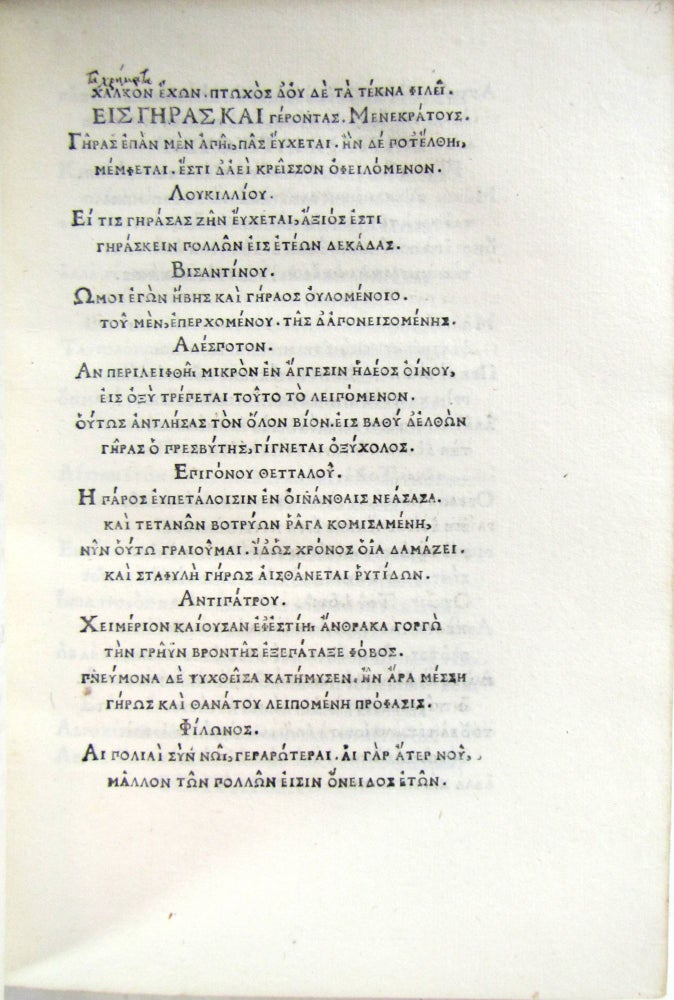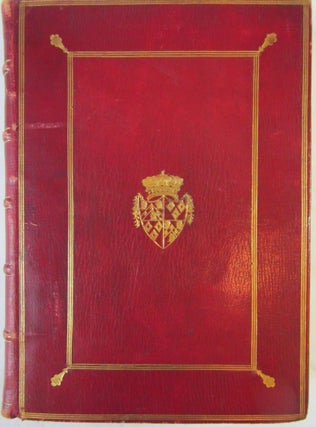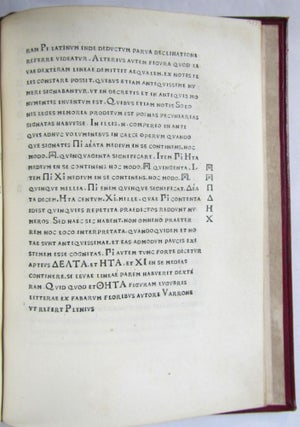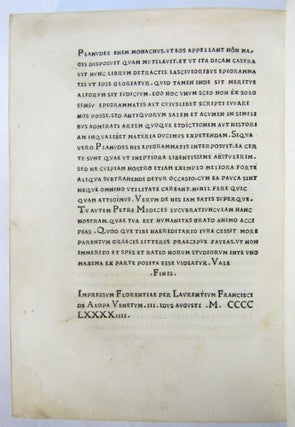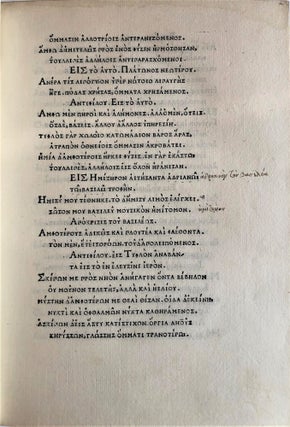Anthologia Graeca Planudea, in Greek. Florence: Lorenzo (son of Francesco) di Alopa, 11 August 1494.
Median 4to (226 x 162 mm). A-Ω AA-KK8; [ΛΛ]8 (A1r blank, A1v Greek alphabet and diphthongs, title and table of contents, A2r-KK8v text; [ΛΛ]1r Lascaris' verse epilogue in Greek, [ΛΛ]1v-7v editor's dedicatory letter to Piero de' Medici in Latin, [ΛΛ]7v Latin colophon, [ΛΛ]8 blank). 280 leaves. Types: 5a and 5b:114Gk (text) and 116R (dedication). 28 lines. Spaces for initials. Irregular line-endings. Occasional light foxing, small marginal dampstain in last quire. Bound ca. 1800 in red morocco gilt for the Duke of Roxburghe, sides panelled with triple gilt fillets, Roxburghe arms stamped at center, spine gilt lettered, edges gilt (a few small scrapes, slightly rubbed), maroon morocco-backed folding case. Provenance: contemporary marginal and interlinear annotations in Greek; a few later marginalia (one note, on N5v, shaved); John, third Duke of Roxburghe (1740-1804), binding, purchased from Molini, Paris, for £17.17, May 1789 (note in red ink on first blank page), Roxburghe sale, 1812, lot 2354, £14.5; George W. Fitzwilliam of Milton Hall, Peterborough, bookplate, sale, Sotheby's, 29 April 1918, lot 19, to Quaritch; C.S. Ascherson (bookplate); Viscount Mersey, Bignor Park bookplate, sale Christie's, 27 November 1991, lot 4, to Carlo Alberto Chiesa; sale, Christie’s London 29 November 2000, lot 39, to Pierre Berès.
Editio Princeps of the Planudean Anthology, the first of Lorenzo di Alopa’s important series of Greek editions; first issue with the editor’s dedicatory letter to Piero de’ Medici; the Roxburghe copy.
Many Hellenistic poets published books of epigrams; these were collected from an early period. A vast collection assembled ca. AD 900 by the Byzantine schoolteacher Constantine Cephalas included the earlier collections as well as a large number of inscriptional epigrams collected from various parts of Greece and Asia Minor. The Palatine Anthology, assembled by an unknown scholar soon after, expanded Cephalas to approximately 3700 epigrams, adding much Christian and ekphrastic poetry. “To this manuscript we owe almost our entire knowledge of Greek epigram from Meleager to Agathias” (Oxford Classical Dictionary, 3rd rev. ed., p. 102). In the 13th century the Byzantine monk Maximus Planudes produced this reduced version of the Palatine Anthology, rearranging the epigrams in seven books with extensive subdivisions, adding some epigrams not included by the Palatine Anthologist (most of which came from a different version of Cephalas’ collection), but also bowdlerizing erotic passages and omitting what he considered improper. Most manuscript copies were made from the Planudean Anthology, the earlier Palatine Anthology having been forgotten. Until the latter’s rediscovery in 1606, the Planudean Anthology was the Greek Anthology, and it exerted a huge influence throughout the Renaissance. “The Greek Anthology is one of the great books of European literature, a garden containing the flowers and weeds of fifteen hundred years of Greek poetry, from the most humdrum doggerel to the purest poetry” (OCD).
Although Planudes’ holograph manuscript was by this time in the collections of Cardinal Bessarion in Venice, the Greek scholar Janus Lascaris used a different manuscript for the present edition; this version was followed by all subsequent editors until the latter half of the eighteenth century.
This was the first of three editions (with the Euripedes and the Gnomae) printed by di Alopa, using a striking uppercase typeface in two fonts, designed by Lascaris to imitate epigraphic letter-forms. As he explains in his dedicatory letter, in this way he hoped to avoid the complications of reproducing Greek script. Lascaris’ type contained ONLY CAPITAL LETTERS, with breathings and accents cast and set separately and attached to the letters of the smaller font by means of solder or wax, so that its body matched perfectly that of the larger font. Though visually arresting, such a typeface proved insufficiently compact for the printing of scholia, and two years later a true lowercase fount − just as complicated as those condemned by Lascaris − was introduced to print commentary, for the editio princeps of the Argonautica.
This copy is from the first issue, containing the final, unsigned quire, with Lascaris’ dedicatory letter in Latin to Piero de' Medici. Which was suppressed from some copies, no doubt those still unsold after Piero was proscribed from Florence and fled the city following the entry of King Charles VIII on 8 November 1494.
ISTC ia00765000; Goff (+ Suppl.) A-765; CIBN A-410; Walsh 2962; Bod-inc. A-308; BMC VI 666; BSB-Ink A-557; GW 2048; Flodr, Anthologia 1; Proctor, Printing of Greek, pp. 78-79; Barker, Aldus Manutius and the Development of Greek Script and Type, pp. 39-42; Wilson From Byzantium to Italy, pp. 98-99.
Price: $60,000.00

